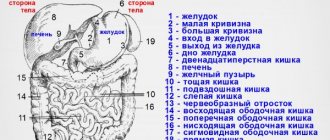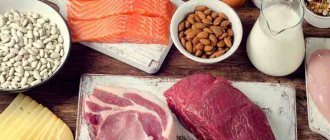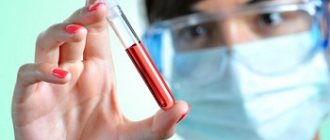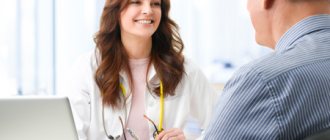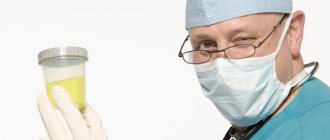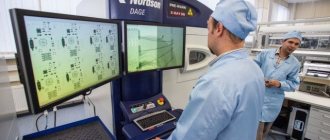Restoration of normal bowel function takes place under the supervision of the attending physician. Nutrition after intestinal colonoscopy is a key point in the prevention of complications after manipulation. To restore intestinal function as quickly as possible, a gentle menu with small, frequent meals is introduced. The products used are easily digestible, with a large amount of vitamins and minerals, and are not capable of injuring the intestinal walls. Often, after a colonoscopy and following a diet, patients forget about the sense of proportion, the need to restore normal intestinal functioning gradually, including excluded foods in the diet in small doses. This can lead to complications - constipation, diarrhea, bloating, gas, bleeding.
Patient's intestines
To eliminate the chance of causing constipation, you should remember to maintain water balance and drink at least 2-2.5 liters of water per day. It is recommended to create a menu taking into account 6-7 meals with an interval of 1.5-2 hours. 30-40 minutes before eating, you need to drink 1 glass of water. Food is not washed down with liquid. For the effective functioning of gastric juice and complete digestion of food, it is important to pause for 40 minutes. Food should be warm: the temperature of cold dishes is above 15 degrees, hot dishes - up to 62 degrees.
Principles of nutrition
Colonoscopy is almost never performed on healthy people.
It is prescribed if there are symptoms of damage to the digestive tract. Therefore, nutrition after colonoscopy of the intestines should meet the general requirements for such pathologies as much as possible. It is based on the following principles:
- Mechanical protection of the intestinal walls. Products and dishes that are used should not irritate or damage the mucous membrane. Therefore, those foods that have solid particles are excluded from the diet.
- Reducing gas formation. Flatulence leads to increased pressure on the intestinal wall, which can lead to severe pain or bleeding.
- Prevention of fecal stagnation. This point is especially relevant for older patients who are often prone to constipation. Therefore, the diet should contain enough fiber to stimulate intestinal motility.
- Increasing the frequency of meals and reducing the portion size. This promotes more complete absorption and reduces the load on the digestive system.
- Taking into account individual characteristics. Foods to which the patient is hypersensitive must be removed from the diet. There are also a number of enzymopathies (deficiencies of certain enzymes) that require the exclusion of certain foods (for example, for celiac disease - those containing gluten).
The essence of the procedure
Colonoscopy is an invasive (penetrating) method of examination using video equipment. A camera is inserted into the organ through a natural opening, which takes pictures and transmits the image to the screen. A prerequisite is to cleanse the intestines of feces. The walls of the empty cavity close together, making examination difficult. Therefore, during the procedure, carbon dioxide is injected to straighten the folds and provide a clear diagnostic picture. The tip of the colonoscope is smooth so as not to scratch the mucous membrane. The doctor's actions should be as careful as possible.
However, if precautions are taken during a colonoscopy, there is still a negative impact on the functionality of the intestines:
- Cleaning with enemas or medicinal laxatives leads to disruption of the microflora of the organ.
- In the colonoscopy format, polyps in the intestines are removed, wounds are coagulated, scars and adhesions are excised. These simple surgical actions cause a response from the body in the form of minor tissue inflammation.
- Carbon dioxide is not completely pumped out after the procedure, so the patient may experience stomach pain after a colonoscopy due to the accumulated gases.
Carefully! The load on the intestines in the form of overeating, heavy foods, and other things can lead to stool disorders, abdominal pain, bloating, and colic. It also provokes inflammation, the growth of polyps, the appearance of erosions and other organ pathologies.
Authorized Products
What can you eat after a colonoscopy? It is recommended to include the following products in the patient’s diet:
- yesterday's wheat bread;
- steam cutlets;
- steamed or baked omelettes;
- mild cheese;
- rice, buckwheat, rolled oats, oatmeal;
- salads from cabbage, carrots, zucchini, cauliflower, tomatoes, dill, parsley;
- mashed potatoes;
- baked cottage cheese pudding;
- apples, pears (both fresh and baked);
- jelly with sugar;
- sweet juices;
- rosehip decoction;
- green tea.
The body's reaction to colonoscopy
Despite the fact that the diagnostic procedure is minimally invasive and is performed with high-quality preparation of the patient for it, the body’s reaction to the insertion of a colonoscope will be present to a greater or lesser extent. These consequences are expressed as follows:
- weakness accompanied by dizziness - this condition may be the body’s response to medications administered to the patient as preparation for general anesthesia or as a reaction to a strict diet before the study;
- abdominal pain is a natural reaction of the intestines to the stretching of its walls by carbon dioxide, as well as traumatic damage to the organ by a colonoscope;
- bloody discharge from the anus - a small amount of it is possible as a result of taking material for histological examination or as a response to the introduction of a foreign body into the intestine;
- diarrhea – a violation of the organ’s ability to absorb excess fluid from the intestinal contents;
- constipation is a disturbance in the peristalsis of the large intestine due to its slowdown.
All these consequences are temporary, and restoration of the intestine after colonoscopy occurs within 2-3 days. But if the recovery process after diagnosis is delayed, it is necessary to consult a specialist to find out the reason for the prolonged recovery.
Prohibited Products
In the first days after a colonoscopy, the following foods are removed from the diet:
- alcohol and carbonated drinks;
- strong tea or coffee;
- legumes (beans, peas, lentils);
- fatty types of meat or fish;
- fried foods;
- fresh baked goods (bread, buns);
- canned foods;
- spices;
- milk, sour cream, cream;
- pearl barley and semolina;
- borscht, okroshka;
- grape juice;
- spinach, sorrel, turnip, beets;
- mushrooms;
- spicy cheese;
- semi-finished products (sausages, meatballs, dumplings).
Prohibited Products
Excluded from food:
- Fried meat products, fish;
- Sausages, canned products, smoked meat, pickles, marinades;
- Whole grain porridge;
- Lentils, chickpeas, beans, peas, rice;
- Confectionery;
- Bakery;
- Pasta;
- Radish, radish, onion, garlic;
- Mushrooms in any form;
- Fried egg;
- Freshly ground coffee;
- Products containing cocoa beans;
- Alcohol;
- Spicy, fatty dishes.
Nutrition after colonoscopy under anesthesia
The most serious restrictions are placed on nutrition if the colonoscopy was performed under anesthesia. This is due to the fact that the drugs used for general anesthesia inhibit the motility of the digestive tract. And if you violate the recommendations, the patient has a high risk of nausea and vomiting. Therefore, on the day of the procedure, light meals are allowed only after 6-8 hours.
The first meal should be liquid. Therefore, the patient is given soups (buckwheat, rice) without meat. Then you can have dinner with light porridge without oil, or fresh mashed potatoes. For drinks, light tea, table still water, and rosehip decoction are recommended.
Starting from the second day after the procedure, the full nutrition that the patient had before the colonoscopy is restored.
What remains in the diet after intestinal diagnosis?
The main friend of digestion is fiber, which is found in fruits, vegetables and herbs. However, large amounts of raw foods can cause flatulence. Therefore, in the first days it is better to eat a lot of greens - dill, parsley, cilantro, basil, and eat vegetables and fruits boiled or baked.
Other recommendations:
- The best dishes for the first days will be soups, broths, puree soups with vegetables, fish, lean meats and poultry;
- Eggs should only be eaten boiled or as part of an omelet;
- Any porridge cooked in water;
- Fermented milk products - fermented baked milk, natural yogurt, kefir, cottage cheese;
- Bread can be eaten in limited quantities, rye or stale white;
- Lean varieties of fish, poultry, meat, boiled or stewed in water;
- For sweets, let's say marshmallows, marmalade, honey;
- Drinks - jelly, green or herbal tea, dried fruit compote.
Attention! It is recommended to grind food as much as possible when cooking or chew each piece thoroughly so as not to damage the inflamed mucous membrane of the organ.
How should a patient eat after a colonoscopy?
To avoid uneven load on the intestines, you should eat up to 6 times a day at regular intervals. The portion should be small, about 200 grams. That's how much goes into two hands without a slide, that's how much you need to eat at one time.
It is important to eat calmly, slowly, and chew thoroughly. Digestive problems are often caused by stress. Therefore, a normal emotional state is important - no fussiness, no thoughts about problems.
How to prepare food for a patient who has undergone an intestinal examination?
After a colonoscopy, it is better to use boiling or stewing in water, or steaming. The consistency of the dishes should be soft, crushed as much as possible. Therefore, porridges and purees are good. It should be baked without oil, and the crust should be removed from the product, it irritates the digestive tract. Frying, deep frying, and smoking are unacceptable during the recovery period.
How long should you limit your diet?
It is recommended to follow the diet after a colonoscopy for about a week. If only intestinal diagnostics were carried out, then it is enough to wait for the first stool. With a balanced diet, it happens within 2-3 days, but may not come until 5-6 days. In the absence of diarrhea, constipation and bloating, you can eat whatever you want after 48-72 hours.
When diagnostics revealed problems and polyps, adhesions or other pathologies were removed during the procedure, the restrictions should be strictly observed in the first week with a gradual relaxation in the future.
Attention! In case of serious intestinal problems, the doctor may recommend a therapeutic diet for a month or even more.
Nutrition after the procedure under general anesthesia
If anesthesia was used during colonoscopy, then on the first day it is permissible to drink only a few sips of water. For the next 2 days, broths, then porridges without milk, soups. All food is pureed until the end of the week. Portions are very small, up to 100 grams at a time. Solid food is introduced gradually, no more than 50 grams. at meals.
Those who have undergone a colonoscopy while sleeping, which is anesthesia using sedation, can begin eating the same day with mild restrictions. That is, under normal conditions.
Drinking regime after colonoscopy
It is very important to supply the body with enough clean water. Without it, the intestines cannot function normally, and constipation occurs. Therefore, you should drink several sips throughout the day. You cannot wash down your food; you need to wait half an hour before or after eating. The amount of water should not be less than 1.5 liters, excluding liquid in food.
Other restrictions after intestinal diagnosis
Not only food and water pass through the gastrointestinal tract, medications can also cause unpleasant consequences. Therefore, after a colonoscopy you should not take:
- Aspirin and other blood thinning drugs. Especially if a biopsy or polyp removal has been performed. Acetylsalicylic acid interferes with blood clotting and healing, which can cause bleeding in the intestines;
- Iron-containing drugs have a similar effect, so you should avoid them for 1-2 weeks.
Expert advice! You should tell your doctor what medications you are taking to avoid dangerous complications.
Nutrition after using Fortrans
If colonoscopy (or irrigoscopy) was performed without general anesthesia, but before that, bowel cleansing was carried out using Fortrans (a laxative based on macrogol), then it is recommended to refrain from eating for another 2-3 hours after the procedure. The diet must include oatmeal, rice or buckwheat porridge, fresh cottage cheese, fermented milk products (kefir, yogurt, fermented baked milk), vegetables (fresh or stewed), tomato or apple juice.
Since when using Fortrans, a large volume of water is expelled from the body, it is important to prevent the development of dehydration. Therefore, in the first hours after colonoscopy, you need to drink at least 1-1.5 liters of water (if there is no concomitant renal or cardiac pathology). In addition to juices, they also use table water, weak tea or decoctions.
The patient returns to normal nutrition (if he feels well) already on the 2nd day.
How to restore the intestines after a colonoscopy
Forced bowel cleansing before a colonoscopy procedure does not go unnoticed, especially if the patient did not follow the recommendations of a nutritionist. But even with proper planning of the diet and eating regimen, stool after colonoscopy can be problematic:
- liquid with normal or increased frequency;
- too hard;
- atypical, containing mucus and blood, etc.
Such problems are caused by the fact that after the examination, disturbances in the microflora and intestinal motility are observed.
You can restore your colon's ability to function normally through diet and moderate physical activity. Regarding the restoration of intestinal microflora after examination with a colonoscope, you will have to use probiotics and prebiotics. These are drugs that cultivate and maintain healthy intestinal microflora.
Important! The method of restoring microflora using foods rich in fiber is not used after colonoscopy, since dietary fiber provokes gas formation and can injure the already irritated mucous membrane.
A much more dangerous phenomenon is when black stool appears, indicating intestinal bleeding. It requires immediate medical intervention; hiding and ignoring such a symptom is life-threatening.
What to do if you are constipated after a colonoscopy
Prolonged constipation after colonoscopy occurs in most patients who undergo this procedure. Its occurrence is considered a normal consequence of prolonged fasting (more than 16 hours) and following a low-fiber diet before the examination. Regular eating and moderate physical activity will help relieve constipation. Drinking plenty of water (at least 2 liters of water per day) will help prevent them.
If within 2 days after the examination there is no stool, although the urge to defecate occurs, it is recommended to use laxatives that accelerate intestinal motility:
- "Duphalac";
- "Forlax";
- "Fortrans".
Important! The use of laxatives on the first day is prohibited, as they can cause intestinal atony. You should also refrain from enemas.
What to do if you have diarrhea after a colonoscopy
Loose stools or diarrhea after a colonoscopy are less common than constipation. In most cases, its causes are dysbiosis and poor diet. This condition is fraught with dehydration, so it is recommended to drink at least 1.5 liters of still mineral water. If diarrhea after a colonoscopy does not go away within 2 days in a row, you can take the following medications:
- "Loperamide";
- "Smecta";
- "Hilak Forte";
- "Diara";
- "Imodium."
In addition, you can use some folk remedies. For example, the bark and fruits of bird cherry, blueberry fruits, and burnet rhizomes have a good astringent effect. A decoction is prepared from them and drunk 100 ml three times a day.
Means for normalizing the environment in the intestines
An imbalance of microflora is a fairly common occurrence after a colonoscopy. This condition is expressed by the fact that the patient has rumbling in the stomach, feels fullness (which indicates gas formation), is bothered by nausea, and a feeling of heaviness.
The following drugs help restore intestinal microflora and improve digestion:
- “Linex” is a balanced pro- and prebiotic agent that can be used even before the appearance of unpleasant symptoms as a preventive measure;
- “Lactobacterin” is a product with live bacteria that helps restore microflora;
- “Bifidumbacterin” is another natural remedy with live bacteria that helps cope with the symptoms of dysbiosis;
- “Hilak Forte” is an organic property based on biosynthetic acid that supports beneficial intestinal microflora and promotes the removal of toxins from the body.
The listed drugs must be used after consultation with a doctor, since despite their safe composition they have a number of contraindications.
Sample menu
Below is an example of a daily menu for a patient with intestinal pathology after a colonoscopy. It can be expanded and supplemented taking into account permitted products.
The first breakfast (around 8-9 am) consists of cooked and pureed rice porridge, two soft-boiled eggs and tea with milk.
Second breakfast (10-11 o’clock) – fresh slightly warmed cottage cheese with sugar and a glass of still mineral water.
For lunch (13-14 hours) you can include buckwheat vegetable soup with potatoes and carrots, mashed potatoes, a veal cutlet (steamed), a baked apple and a glass of rose hips.
The afternoon snack (16-17 hours) consists of dry cookies and a glass of milk.
Dinner (19-20 hours) includes oatmeal, cooked in water or milk, and boiled lean fish . Drinks include weak tea.
Before bedtime (22 hours), a glass of non-acidic yogurt is enough.
What sensations can you expect after a colonoscopy?
- bloating, flatulence. Caused by the accumulation of air supplied to inflate the intestinal loops for optimal viewing. Advanced colonoscopes supply carbon dioxide, which is almost completely absorbed, but most devices still operate on atmospheric air.
- discomfort, mild pain.
- discharge of drops of blood within 24-48 hours after completion of the examination. This is especially true when removing polyps and biopsies.
Products for restoring intestinal microflora
Some gastroenterologists and endoscopists believe that after a colonoscopy, a disorder of the intestinal microflora develops. And this is precisely what explains the feeling of heaviness, the tendency to diarrhea or constipation that develops in some patients after the procedure.
Therefore, they are prescribed a special diet high in fermented milk products and fiber, which is found in fruits and vegetables.
Additionally, a number of drugs with spores of beneficial microorganisms are used (“ Linex ”, “ Bifidumbacterin ”).
However, the role of intestinal dysbiosis in domestic medicine is greatly exaggerated. There is no convincing data yet on the role of microflora disorders in the development of negative symptoms after colonoscopy. They are advised to be included in the concept of “irritable bowel syndrome”. It develops due to mechanical pressure on the walls, microtraumatization of the mucous membrane and impaired motility. Usually, even without special treatment, the syndrome goes away after 2-3 days with a properly selected diet.
What is a colonoscopy?
Colonoscopy is a hardware type of examination of the large intestine. The essence of the method: a thin tube equipped with a lighting device and optical equipment is inserted into the anus. Modern fiber colonoscopes have more elastic probes, and there are video cameras that transmit images to a monitor.
For the procedure to help in diagnosis, preliminary cleansing of the intestines is necessary. At the preparatory stage, the doctor prescribes a slag-free diet for 3-7 days. Foods that are difficult to digest, contain fiber, fats, cause gas formation, and irritate the intestines are excluded from the diet. Additionally, special laxatives and enemas are used for cleansing. Each patient is interested in the correct fulfillment of the requirements, since the procedure is unpleasant, and one does not want to repeat it due to unreliable data.
The capabilities of endoscopic technology with a high probability make it possible to identify the slightest deviations in the structure of the inner membrane, foci of inflammation, ulcers, erosions, sources of bleeding, scars, foreign bodies, and neoplasms. Tissue is taken from different points for biopsy examination, which serves as an important diagnostic method for detecting colon cancer at an early stage.
Prevention of complications
To avoid complications, you need to know several important rules of diet after intestinal colonoscopy:
- If the patient is allergic to food or medication, he must inform the doctor and nutritionist about this.
- After a colonoscopy, you should resume oral nutrition on the same day in order to normalize the digestive system as quickly as possible.
- When using laxatives (Fortrans and others), it is important to drink enough fluids after endoscopy.
- Carefully select and prepare dishes.
- Do not smoke or abstain from this habit as much as possible.
Consequences of a medical procedure for the gastrointestinal tract
The recovery period begins on the day of the study and lasts about a week. In addition to a gradual expansion of the diet, it includes restrictions on the regimen (smoking, active physical activity is undesirable), and herbal medicine techniques. If a patient suffers from chronic diseases of the digestive system, then the main task is to bring him to his usual menu.
Colonoscopy is rare, but does cause complications. Sometimes they are dangerous to humans and require urgent surgical intervention. Undesirable consequences include:
Perforation of the intestine by the tip of the probe - the frequency is no more than 1% of all cases. This complication is difficult to diagnose immediately if the patient’s consciousness is confused by sedatives or disabled by anesthesia. It is to eliminate such a risk that endoscopists try to persuade the patient to endure the unpleasant sensations and perform a colonoscopy under local anesthesia. The risk of rupture is judged by the reaction and pain when advancing the tube.
Nutritionist's recommendations
When preparing your own diet after a colonoscopy, you should always pay attention to the following nuances:
- The consumption of alcoholic and carbonated drinks is completely excluded.
- The diet should be balanced. The patient must consume sufficient amounts of nutrients, vitamins, microelements and fluids.
- Monitor the quality of the products used for cooking. They must be fresh and purchased from trusted sellers.
- Remove all solids from food (cartilage from meat, bones and scales from fish).
- The temperature of the food should not be too high or low (optimally 35-45°C).
- The menu during the rehabilitation period should be varied. You should not cook the same dishes every day, as they quickly get boring.
- It is advisable to take into account the patient's preferences. If he categorically refuses to drink yogurt, you should not force him. It is better to choose another fermented milk product.
What foods are not recommended to be consumed in the first days after a colonoscopy?
It is imperative to exclude from the menu all ingredients that provoke increased gas production:
- Fresh bread made from premium flour;
- Whole grain;
- Legumes - peas, beans, chickpeas, lentils, beans;
- Cabbage;
- Garlic, radish, turnip, radish;
- Pastries, sweets;
- Milk.
Anything that irritates the exposed intestinal mucosa is prohibited:
- Spicy seasonings;
- Vinegar, spicy sauces;
- Roast;
- Preparations, marinades;
- Coffee and strong tea;
- Alcoholic drinks;
- Bitter chocolate;
- Sausages, smoked meats.
You should not eat pasta before the first bowel movement after a colonoscopy, because it creates a lot of feces, which does not move well through the intestines. Mushrooms are also not recommended; they are a very difficult to digest product that can even cause indigestion if consumed in excess. Fatty foods also require longer and more labor-intensive processing and should be avoided. The amount of potatoes should be reduced.
Description of the procedure and indications for its implementation
Colonoscopy is an invasive endoscopic examination. Therefore, when performing it, it is necessary to anesthetize the intestinal mucosa.
A special optical device placed on a special probe is inserted into the patient's anus. In order to study the internal state of the organ, the doctor monitors its progress in the required direction.
The most common indications for colonoscopy are:
- Crohn's disease;
- polyposis;
- ulcerative colitis;
- inflammatory process;
- stenosis;
- bloody discharge from the anus;
- intestinal obstruction;
- abdominal pain of unknown etiology;
- severe dysfunction of the digestive system;
- sensations of foreign inclusion in the anus;
- constant constipation;
- frequent diarrhea;
- chronic flatulence;
- iron deficiency anemia, which has no explanation;
- excision of benign neoplasms;
- monitoring after treatment, etc.
To ensure that colonoscopy does not cause harm to the body, you must strictly adhere to the reasons for carrying out the study.
What to do in case of various complications
In cases where the above-described symptoms do not go away after a day or two, but intensify, one can suspect that this is how complications after intestinal colonoscopy manifest themselves. You need to urgently consult a doctor to find out the cause of the illness and get qualified help.
For weakness
Help restore normal well-being:
- Intravenous infusion of saline solution. Replenishes fluid lost due to diarrhea.
- Injections of Rheosorbilact or similar agents containing minerals.
- Injections of vitamins from groups B and C effectively stimulate the functioning of the immune system, as well as the nervous and muscle systems.
For diarrhea
From medical means you can use:
- Smecta – 1 sachet three times a day.
- Loperamide. It inhibits the movement of feces through the intestines, while excess liquid is absorbed from it and feces of normal consistency are formed.
- Hilakom forte. Take 40 drops three times a day. An effective remedy for stimulating the growth of healthy microflora in the intestinal cavity.
Self-prepared decoctions also help well with loose stools after colonoscopy:
- from St. John's wort;
- burnet rhizomes;
- blueberries;
- bird cherry fruit.
For constipation
In this case, drugs from the group of laxatives will help:
- Duphalac – stimulates intestinal motility. You need to take 25 ml in the morning with meals.
- Bisacodyl - enhances the secretion of mucous secretion by the glands of the large intestine, thereby facilitating the passage of feces. Take 2 tablets before going to bed.
- Forlax - restores intestinal motility. Take one sachet 1 time per day.
When bleeding
A complication of bleeding after colonoscopy is considered to be a combination of symptoms:
- significant discharge of scarlet blood from the anus;
- progressive drop in blood pressure and increasing weakness;
- increased heart rate.
Such symptoms indicate internal bleeding. The condition requires immediate medical attention before it becomes dangerous.
Assistance is provided in a hospital setting, where hemostatic therapy is carried out. In difficult situations, plasma or blood is transfused.
When pus is discharged
Fever, accompanied by an increase in body temperature, and purulent discharge indicate the onset of an inflammatory process in the lumen of the large intestine as a result of infection during examination.
Treatment consists of the following:
- antibacterial agents;
- detoxification therapy.
For intense pain syndrome
If the patient after a colonoscopy has unbearable pain, which is accompanied by:
- vomiting without relief;
- severe condition with loss of consciousness;
- bloating;
- the patient lies on his side with his legs tucked to his chest;
- the anterior wall of the abdomen is tense and has taken on a board-like shape.
Such symptoms may indicate a very dangerous complication - perforation of the wall of the large intestine. This complication is rare, but urgent measures must be taken, that is, immediate hospitalization and emergency surgery, otherwise the patient may die.
What can you eat after a colonoscopy?
If a colonoscopy was done for diagnostic purposes, then after it the patient can return to their usual diet. For some time after the procedure, there may be flatulence, which is a consequence of air entering the intestines during the procedure. If bloating bothers you for several days, it is recommended to take enterosorbents (Polysorb, BAU).
If a colonoscopy was done for therapeutic purposes, the diet must be gentle and easily digestible in order to prevent strong peristalsis in the intestines. Food should be rich in macro- and microelements, with a predominance of plant products. This will be a good means of preventing bleeding and intestinal infections. It is forbidden to overeat and drink food.
First of all, the attending physician needs to tell the patient about his diet. If a proctologist or general surgeon removed intestinal polyps, then for the first 2-4 days all dishes should have a jelly-like or liquid consistency. You should not eat bread, solid foods, foods containing fiber, or dairy products. The number of meals can be 6-8 per day. The patient should eat every 2-3 hours, including at night, in portions of 250-300 milliliters.
A week and a half after the procedure, you can start eating fruit and berry purees, dairy products - snowball, kefir, low-fat cottage cheese. Whole milk, as well as fatty, fried, salted, spicy, smoked, and pickled milk should not be consumed.
After three weeks, nutrition after intestinal colonoscopy becomes most balanced. Allowed are porridges cooked in milk, low-fat broths, potatoes in any form except fried, and freshly squeezed juices. The preferred protein sources are seafood, poultry, rabbit, beef, and turkey. It is recommended to remove foods high in fiber from the diet.
